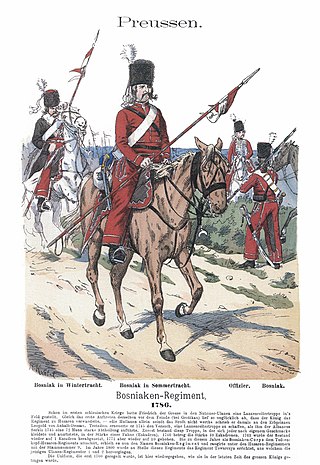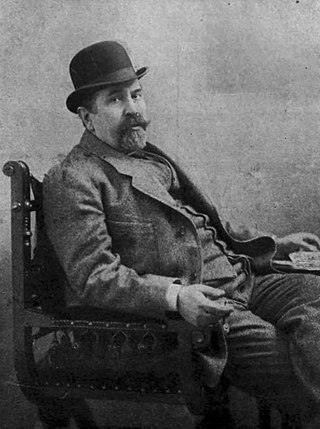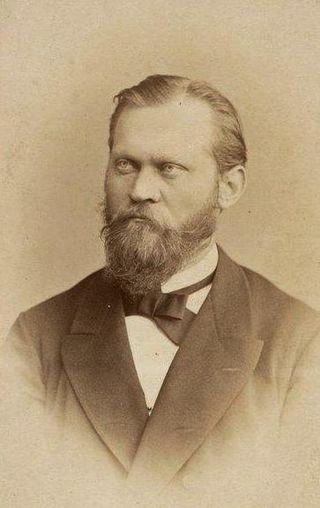
Bosnian, sometimes referred to as Bosniak language, is the standardized variety of the Serbo-Croatian pluricentric language mainly used by ethnic Bosniaks. Bosnian is one of three such varieties considered official languages of Bosnia and Herzegovina, along with Croatian and Serbian. It is also an officially recognized minority language in Croatia, Serbia, Montenegro, North Macedonia and Kosovo.
Four major international peace plans were proposed before and during the Bosnian War by European Community (EC) and United Nations (UN) diplomats before the conflict was settled by the Dayton Agreement in 1995.

This article is about the Demographic history of Bosnia and Herzegovina, and deals with the country's documented demographics over time. For an overview of the various ethnic groups and their historical development, see Ethnic groups in Bosnia and Herzegovina.

Ćiro Truhelka was a Croatian archeologist, historian, and art historian who devoted much of his professional life to the study of the history of Bosnia and Herzegovina. He wrote about prehistory, Roman and medieval history, Ottoman and Turkish documents from the region, stećci, and Bosnian Cyrillic. He was also engaged in albanology. He was the first curator of the National Museum of Bosnia and Herzegovina.
Miloš Okuka is a Serbian linguist, Slavist, dialectologist and literature historian.
This is a survey of the postage stamps and postal history of Bosnia and Herzegovina.

The Bosniak Corps was a Prussian Army unit of lancers of Bosnian origin. In 1745 they were organised in the 1st Hussar Regiment "von Ruesch".

The House of Pavlović, also Radinović or Radenović, or Radinović-Pavlović, was Bosnian noble family who got their name after Radin Jablanić. Radin's father, Jablan, was a founder of Jablanić house, an earlier branch of this medieval Bosnian clan. Jablan's estate was in Jablan village. Later, family extended their feudal possessions from the Middle and Upper Drina river in the eastern parts of medieval Bosnia to south-southeastern regions of the Bosnian realm in Hum, and Konavle at the Adriatic coast. The family official residence and seat was at Borač and later Pavlovac, above the Prača river canyon, between present-day Prača, Rogatica and Goražde in Bosnia and Herzegovina.
Gornje Vodičevo is a village in the municipality of Novi Grad, Republika Srpska, Bosnia and Herzegovina. It consists of twenty hamlets; among them are Kukavice, Vukovići, Kestenova Dolina, Bundale, Rekići, Potok, Žljeba, Šurlani (Stanići), Kolundžije, and Đurđevići-Zecovi.

Lajos Thallóczy was a Hungarian historian, a politician and diplomat, the head of the joint finance department of the Dual Monarchy, a member of the Hungarian Academy of Sciences, the president of the Hungarian Historical Society from 1913 to 1916 and a renowned albanologist. As a diplomat in Austria-Hungary he played a very significant role in the Balkans as he was considered an expert on the history of the region. He was one of the most important advisers to Gyula Andrássy and Béni Kállay in questions of Balkan policy and even to the emperor Franz Joseph and to the minister of the government. His academic work has produced respected results in the study of south Slavic countries and he is regarded as the founder of modern Hungarian researches of the Balkans.

Carl Ludwig Patsch, also Karl Ludwig Patsch, Albanian: Karl Paç; Bulgarian: Карл Пач was an Austrian Slavist, Albanologist, archaeologist and historian.
Friedrich Katzer was an Austrian geologist and mineralogist.
The 1885 population census in Bosnia and Herzegovina was the second census of the population of Bosnia and Herzegovina taken during the Austro-Hungarian occupation.
The 1910 population census in Bosnia and Herzegovina was the fourth census of the population of Bosnia and Herzegovina taken during the Austro-Hungarian Condominium of Bosnia and Herzegovina

Emil Ernst August Tietze was an Austrian geologist.

The campaign to establish Austro-Hungarian rule in Bosnia and Herzegovina lasted from 29 July to 20 October 1878 against the local resistance fighters supported by the Ottoman Empire. The Austro-Hungarian Army entered the country in two large movements: one from the north into Bosnia, and another from the south into Herzegovina. A series of battles in August culminated in the fall of Sarajevo on the 19th after a day of street-to-street fighting. In the hilly countryside a guerrilla campaign continued until the last rebel stronghold fell after their leader was captured.

Vlachs in medieval Bosnia and Herzegovina were a Western Balkans population descending from a mixture of Romanized pre-Slavic Romance-speaking peoples and the South Slavs. From the 14th century the ethnic meaning of term "Vlach" was replaced with societal meaning and often meant the Slavic population with similar lifestyle. They practiced transhumance as herdsmen, shepherds, farmers, and in time developed peculiar socio-political organizational units known as katuns. With their caravans, Vlach carried out much of the traffic between inland and coastal cities such as Dubrovnik. They also had close contacts and militarily served various Bosnian noble families and kings.

Ivan Lovrenović is a Bosnian and Herzegovinian publicist, writer, historian, essayist, and editor.
Srećko Matko Džaja is a Bosnian Croat-German historian, medievalist and ottomanist.

Bosnia and Herzegovina–Germany relations are the bilateral relations between Bosnia and Herzegovina and the Federal Republic of Germany. Diplomatic relations between Bosnia and Herzegovina and Germany have existed since 1992. Bosnia and Herzegovina has an embassy in Berlin and consulates general in Frankfurt am Main, Munich and Stuttgart. Germany maintains an embassy in Sarajevo.















